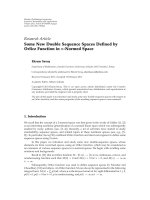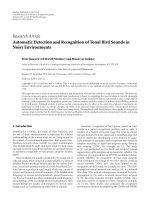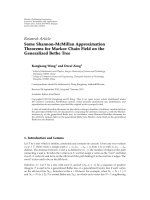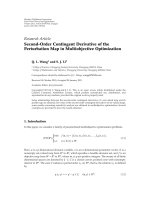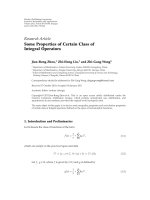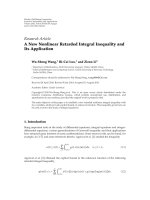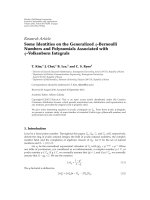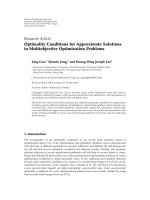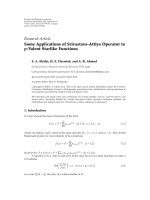Báo cáo hoa học: " Research Article ¨ Some Basic Difference Equations of Schrodinger Boundary Value Problems" docx
Bạn đang xem bản rút gọn của tài liệu. Xem và tải ngay bản đầy đủ của tài liệu tại đây (570.35 KB, 22 trang )
Hindawi Publishing Corporation
Advances in Difference Equations
Volume 2009, Article ID 569803, 22 pages
doi:10.1155/2009/569803
Research Article
Some Basic Difference Equations of Schr
¨
odinger
Boundary Value Problems
Andreas Ruffing,
1, 2
Maria Meiler,
2
and Andrea Bruder
3
1
Center for Applied Mathematics and Theoretical Physics (CAMTP), University of Maribor,
Krekova Ulica 2, 2000 Maribor, Slovenia
2
Department of Mathematics, Technische Universit
¨
at M
¨
unchen, Boltzmannstraße 3,
85747 Garching, Germany
3
Department of Mathematics, Baylor University, One Bear Place 97328, Waco, TX 76798-7328, USA
Correspondence should be addressed to Andreas Ruffing, ruffi
Received 1 April 2009; Accepted 28 August 2009
Recommended by Alberto Cabada
We consider special basic difference equations which are related to discretizations of Schr
¨
odinger
equations on time scales with special symmetry properties, namely, so-called basic discrete
grids. These grids are of an adaptive grid type. Solving the boundary value problem of suitable
Schr
¨
odinger equations on these grids leads to completely new and unexpected analytic properties
of the underlying function spaces. Some of them are presented in this work.
Copyright q 2009 Andreas Ruffing et al. This is an open access article distributed under the
Creative Commons Attribution License, which permits unrestricted use, distribution, and
reproduction in any medium, provided the original work is properly cited.
1. Introduction
It is well known that solving Schr
¨
odinger’s equation is a prominent L
2
-boundary value
problem. In this article, we want to become familiar with some of the dynamic equations
that arise in context of solving the Schr
¨
odinger equation on a suitable time scale where the
expression time scale is in the context of this article related to the spatial variables.
The Schr
¨
odinger equation is the partial differential equation t ∈ R
−
∂
2
∂x
2
−
∂
2
∂y
2
−
∂
2
∂z
2
V
x, y,z
ψ
x, y,z, t
i
∂
∂t
ψ
x, y,z, t
, 1.1
where the function V : Ω ⊆ R
3
→ R yields information on the corresponding physically
relevant potential. The solutions of the Schr
¨
odinger equation play a probabilistic role, being
modeled by suitable L
2
-functions. For the convenience of the reader, let us first cite some
2 Advances in Difference Equations
of the fundamental facts on Schr
¨
odinger’s equation. To do so, let us denote by C
2
Ω all
complex-valued functions which are defined on Ω and which are twice differentiable in each
of their variables.
Definition 1.1. Let ψ : Ω → C be twice partially differentiable in its three variables. Let
moreover V : Ω → R be a piecewise continuous function, PΩ denoting the space of
piecewise continuous functions with values in C. The linear map H : C
2
Ω → PΩ,given
by
Hψ
x, y,z
:
−
∂
2
∂x
2
−
∂
2
∂y
2
−
∂
2
∂z
2
V
x, y,z
ψ
x, y,z
1.2
is called Schr
¨
odinger Operator in C
2
Ω.
The following lemma makes a statement on the separation ansatz of the conventional
Schr
¨
odinger partial differential equation where we throughout the sequel assume ΩR
3
.
Lemma 1.2 Separation Ansatz. Let the Schr
¨
odinger equation 1.1 be given, fulfilling the
assertions of Definition 1.1 where ΩR
3
. In addition, the function V will have the property
V : R
3
−→ R,
x, y,z
−→ V
x, y,z
f
x
g
y
h
z
, 1.3
where f, g, h are continuous. Let now λ
1
,λ
2
,λ
3
∈ R be such that there exist eigenfunctions
ψ
1
,ψ
2
,ψ
3
∈L
2
R ∩ C
2
R with
−ψ
1
x
f
x
ψ
1
x
λ
1
ψ
1
x
,x∈ R,
−ψ
2
y
g
y
ψ
2
y
λ
2
ψ
2
y
,y∈ R,
−ψ
3
z
h
z
ψ
3
z
λ
3
ψ
3
z
,z∈ R.
1.4
Then the function ϕ ∈ L
2
R
3
× C
2
R ∩ C
2
R
4
, given by
x, y,z, t
−→ ϕ
x, y,z, t
: ψ
1
x
ψ
2
y
ψ
3
z
e
−iλ
1
t−iλ
2
t−iλ
3
t
1.5
is a solution to Schr
¨
odinger’s equation 1.1, revealing a completely separated structure of the
variables.
A fascinating topic which has led to the results to be presented in this article is
discretizing the Schr
¨
odinger equation on particular suitable time scales. This might be of
importance for applications and numerical investigations of the underlying eigenvalue and
spectral problems. Let us therefore restrict to the purely discrete case, that is, we are going to
focus on a so-called basic discrete quadratic grid resp. on its closure which is a special time scale
T with fascinating symmetry properties.
Advances in Difference Equations 3
Definition 1.3. Let 0 <q<1 as well as c
1
,c
2
,c
3
∈ R.Theset
R
c
1
,c
2
,c
3
q
:
c
1
q
n
c
2
q
−n
c
3
| n ∈ Z
1.6
denotes the basic discrete quadratic grid where c
2
1
c
2
2
/
0. For n ∈ Z, we abbreviate γ
n
: c
1
q
n
c
2
q
−n
c
3
and −R
c
1
,c
2
,c
3
q
: {t ∈ R |−t ∈ R
c
1
,c
2
,c
3
q
} . Define the set
T :
R
c
1
,c
2
,c
3
q
∪−R
c
1
,c
2
,c
3
q
1.7
as well as the set T
∗
by
T
∗
T \
{
0
}
. 1.8
The boundary conditions on the functions we need for the discretized version of
Schr
¨
odinger’s equation are then given by the requirement
L
2
T
∗
:
f : T
∗
−→ C |
f, f
< ∞
,
1.9
where the scalar product f, g for two suitable functions f, g : T
∗
→ R will be specified by
f, g
:
∞
n−∞
γ
n1
− γ
n
f
γ
n
g
γ
n
f
−γ
n
g
−γ
n
.
1.10
In this context, we assume that |γ
n1
− γ
n
|
/
0 for all n ∈ Z. By construction, it is clear that
L
2
T
∗
is a Hilbert space over C as it is a weighted sequence space, one of its orthogonal bases
being given by all functions e
σ
n
: T \{0}→{0, 1} which are specified by e
σ
n
τq
m
: δ
mn
δ
στ
with m, n ∈ Z and σ, τ ∈{1, −1}.
Already now, we can say that the separation ansatz for the discretized Schr
¨
odinger
equation will lead us to looking for eigensolutions of a given Schr
¨
odinger operator in the
threefold product space L
2
T
∗
×L
2
T
∗
×L
2
T
∗
.
Hence we come to the conclusion that in case of the separation ansatz for the
Schr
¨
odinger equation, the following rationale applies:
The solutions of a Schr
¨
odinger equation on a basic discrete quadratic grid are directly
related to the spectral behavior of the Jacobi operators acting in the underlying weighted
sequence spaces.
Before presenting discrete versions of the Schr
¨
odinger equation on basic quadratic
grids, let us first come back to the situation of Lemma 1.2 where we now assume that the
potential is given by the requirement
f
x
x
2
,g
y
y
2
,h
z
z
2
,
x, y,z
∈ R
3
.
1.11
Hence, it is sufficient to look at the one-dimensional Schr
¨
odinger equation
−ψ
x
x
2
ψ
x
λψ
x
. 1.12
4 Advances in Difference Equations
For the convenience of the reader, let us refer to the following fact. let the sequence of
functions ψ
n
n∈N
0
be recursively given by the requirement
ψ
n1
x
: −ψ
n
x
xψ
n
x
,x∈ R,n∈ N
0
, 1.13
where ψ
0
: R → R,x → ψ
0
x : e
−
1/2
x
2
. We then have ψ
n
∈L
2
R ∩ C
2
R for n ∈ N
0
and
moreover
−ψ
n
x
x
2
ψ
n
x
2n 1
ψ
n
x
,x∈ R,n∈ N
0
. 1.14
This result reflects the celebrated so-called Ladder Operator Formalism. We first review
a main result in discrete Schr
¨
odinger theory that is a basic analog of the just described
continuous situation. Let us therefore state in a next step some more useful tools for the
discrete description.
Definition 1.4. Let 0 <q<1andletT be a nonempty closed set with the properties
∀x ∈ T : qx ∈ T,q
−1
x ∈ T, −x ∈ T.
1.15
Let for any f : T → R the right-shift resp. left-shift operation be fixed through
Rf
x
: f
qx
,
Lf
x
: f
q
−1
x
,x∈ T, 1.16
respectively, the right-hand resp. left-hand basic difference operation will for any function
f : T
∗
→ R be given by
D
q
f
x
:
f
qx
− f
x
qx − x
,
D
q
−1
f
x
:
f
q
−1
x
− f
x
q
−1
x − x
,x∈ T \
{
0
}
.
1.17
Let moreover α>0andlet
g : T \
{
0
}
−→ R,x−→ g
x
:
ϕ
qx
−
ϕ
x
ϕ
x
q − 1
x
1 α
1 − q
x
2
− 1
qx − x
,
1.18
where the positive even function ϕ : T → R
is chosen as a solution to the basic difference
equation
ϕ
qx
1 α
1 − q
x
2
ϕ
x
,x∈ T. 1.19
The creation operation A
∗
resp. annihilation operation A are t hen introduced by their actions on
any ψ : T
∗
→ R as follows:
A
∗
ψ
−D
q
g
X
R
ψ, Aψ q
−1
LD
q
Lg
X
ψ.
1.20
Advances in Difference Equations 5
We refer to the discrete Schr
¨
odinger equation with an oscillator potential on T
∗
by
q
−1
−D
q
g
X
R
LD
q
Lg
X
ψ λψ.
1.21
The following result reveals that the discrete Schr
¨
odinger equation with an oscillator
potential on T
∗
shows similar properties than its classical analog does.
Lemma 1.5. Let the function ϕ be specified like in Definition 1.4 , satisfying the basic difference
equation 1.19 on R
c
1
,0,0
q
with c
1
/
0. Let more over ψ
0
: R
c
1
,0,0
q
→ R,x → ψ
0
x :
ϕx.
For n ∈ N
0
, the functions ψ
n
: R
c
1
,0,0
q
→ R, given by ψ
n
x :A
∗
n
ψ
0
x (while x ∈ R
c
1
,0,0
q
)
are well defined in L
2
R
c
1
,0,0
q
and solve the basic Schr
¨
odinger equation 1.21 in the following sense:
q
−1
−D
q
g
X
R
LD
q
Lg
X
ψ
n
q
n
− 1
q − 1
ψ
n
,
A
∗
ψ
n
ψ
n1
,Aψ
n
q
n
− 1
q − 1
ψ
n−1
,ψ
n
x
H
q
n
x
ψ
0
x
,
H
q
n1
x
− αq
n
xH
q
n
x
α
q
n
− 1
q − 1
H
q
n−1
x
0,H
q
0
x
1,H
q
1
x
αx.
1.22
These relations apply for x ∈ R
c
1
,0,0
q
and n ∈ N
0
where one set ψ
−1
: 0,H
q
−1
: 0. Moreover,
the corresponding moments of the orthogonality measure for the polynomials H
q
n
n∈N
0
, arising from
1.19, are given by
μ
2n2
q
−2n−1
− 1
α
1 − q
μ
2n
,μ
2n1
0,n∈ N
0
. 1.23
The proof for the lemma is straightforward and obeys the techniques in 1.
The following central question concerning the functions spaces behind the
Schr
¨
odinger equation 1.21 is open and shall be partially attacked in the sequel.
1.1. Central Problem
What are the relations between the linear span of all functions ψ
n
,n ∈ N
0
arising from
Lemma 1.5 and the function space L
2
R
c
1
,0,0
q
?
In contrast to the fact that the corresponding question in the Schr
¨
odinger differential
equation scenario is very well understood, the basic discrete scenario reveals much more
structure which is going to be presented throughout the sequel of this article.
All the stated questions are closely connected to solutions of the equation
ϕ
qx
1 α
1 − q
x
2
ϕ
x
,x∈ T 1.24
6 Advances in Difference Equations
which originated in context of basic discrete ladder operator formalisms. We are going to
investigate the rich analytic structure of its solutions in Section 2 and are going to exploit
new facts on the corresponding moment problem in Section 3 of this article.
Let us remark finally that we will—throughout the presentation of our results in this
article—repeatedly make use of the suffix basic. The meaning of it will always be related to
the basic discrete grids that we have introduced so far.
The following results will shed some new light on function spaces which are behind
basic difference equations. They are not only of interest to applications in mathematical
physics but their functional analytic impact will speak for itself. The results altogether show
that solving the boundary value problems of Schr
¨
odinger equations on time scales that have
the structure of adaptive grids is a wide new research area. A lot of work still has to be
invested into this direction.
For more physically related references on the topic, we invite the interested reader to
consider also the work in 2–5.
For the more mathematical context, see, for instance, 1, 6–12.
2. Completeness and Lack of Completeness
In the sequel, we will make use of the basic discrete grid:
R
q
:
±q
n
| n ∈ Z
, 2.1
and we will consider the Hilbert space
L
2
R
q
:
f : R
q
−→ C |
∞
n−∞
q
n
f
q
n
f
q
n
f
−q
n
f
−q
n
< ∞
. 2.2
Theorem 2.1. Let 0 <q<1 and α>0 as well as ϕ an even positive solution of
ϕ
qx
1 α
1 − q
x
2
ϕ
x
2.3
on the basic discrete grid R
q
. Let the sequences of functions ϕ
m
m∈Z
be given by shifted versions of
the ϕ-function as follows:
ϕ
m
∈L
2
R
q
ϕ
m
: R
q
−→ R,x−→ ϕ
m
x
: ϕ
q
m
x
ϕ
−q
m
x
,m∈ Z,
ψ
m
∈L
2
R
q
ψ
m
: R
q
−→ R,x−→ ψ
m
x
: xϕ
q
m
x
,m∈ Z.
2.4
The finite linear complex span of precisely all the functions ϕ
m
m∈Z
and ψ
m
m∈Z
is then dense in
L
2
R
q
.
Advances in Difference Equations 7
Proof. Let ϕ ∈L
2
R
q
be a positive and even solution to
ϕ
qx
1 α
1 − q
x
2
ϕ
x
,x∈ R
q
. 2.5
One can easily show that an L
2
R
q
-solution with these properties uniquely exists, up to a
positive factor, moreover all the functions defined by 2.4 are well defined in L
2
R
q
.Letus
refer by the sequence P
n
n∈N
0
to all the orthonormal polynomials P
n
: R
q
→ R which arise
from the Gram-Schmidt procedure with respect to the function ϕ
2
. They satisfy a three-term
recurrence relation
P
n1
x
− α
n
xP
n
x
β
n
P
n−1
x
0,P
−1
x
0,x ∈ R
q
,n∈ N
0
, 2.6
where for n ∈ N
0
the coefficients α
n
,β
n
may be determined by standard methods through the
moments resulting from 2.5.Fromthebasicdifference equation 2.5 we may also conclude
that the polynomials P
n
n∈N
0
are subject to an indeterminate moment problem, we come back
to this in Section 3.
For n ∈ N
0
and x ∈ R
q
, the functions given by P
n
xϕx may now be normalized, let
us denote their norms by ρ
n
where n is running in N
0
.Letusforn ∈ N
0
moreover denote the
normalized versions of the functions P
n
ϕ by u
n
.
The following observation is essential. the C-linear finite span of all functions given by
R
m
ϕ
x
,x
R
m
ϕ
x
,x∈ R
q
,m∈ Z 2.7
is the same than the C-linear finite span of all functions specified by
R
m
u
n
x
,x
R
m
u
n
x
,x∈ R
q
,m∈ Z,n∈ N
0
. 2.8
As a consequence of 2.6, we conclude that the functions u
n
n∈N
0
fulfill the recurrence
relation:
ρ
n1
u
n1
x
− α
n
ρ
n
xu
n
x
β
n
ρ
n−1
u
n−1
x
0,u
−1
x
0,x ∈ R
q
,n∈ N
0
. 2.9
How ever 2.9 can be brought into the standard form which is of relevance for considering
the corresponding Jacobi operator,
Xu
n
a
n1
u
n1
a
n
u
n−1
,n∈ N
0
, 2.10
where the coefficients are given by a
0
0,a
n1
β
n1
/α
n
α
n1
,n∈ N
0
.
The representation 2.10 results from the fact that the functions u
n
n∈N
0
constitute
a system of orthonormal functions and due to the fact that X, acting as a multiplication
8 Advances in Difference Equations
operator, requires to be a formally symmetric linear operator on the finite linear span of the
orthonormal system u
n
n∈N
0
. Let us now consider the Hilbert space:
H :
∞
n0
c
n
u
n
|
∞
n0
|
c
n
|
2
< ∞,c
n
∈ C,n∈ N
0
. 2.11
As for the definition range of X in H, let us choose X as a densely defined linear operator in
H where we assume that
D
X
:
k
n0
c
n
u
n
| c
n
∈ C,k ∈ N
0
.
2.12
Let the expansion for a possible eigenvector of the adjoint X
∗
be written as
∞
j0
c
j
ψ
j
,the
eigenvalue equation being X
∗
∞
j0
c
j
ψ
j
λ
∞
j0
c
j
ψ
j
. Note that the type of moment problem
behind is related to the situation that X : DX ⊆H→Hhas deficiency indices 1, 1. This
also implies that any λ ∈ C constitutes an eigenvalue of X
∗
, hence the point spectrum of X
∗
is
C. According to the deficiency index structure 1, 1 of the operator X, let us now choose the
particular self-adjoint extension Y of X which allows a prescribed real-eigenvalue λ 1
/
0.
The corresponding situation for the eigensolution may be written as
Y
n
j0
c
j
u
j
n
j0
c
j
u
j
w
n
,n∈ N
0
,
2.13
where the sequence w
n
n∈N
0
converges to 0 in the sense of the canonical L
2
R
q
-norm.
The element
n
j0
c
j
u
j
is in the finite linear space of all functions u
j
,j ∈ N
0
. Applying
the powers R
k
,k ∈ Z of the shift operator R being given by Rvx : vqx for any function
v ∈L
2
R
q
,x ∈ R
q
to 2.13 now leads to the fact that we can construct all eigenfunctions of
the operator Y belonging to q
k
,k ∈ Z, as a consequence of
R
k
Y
n
j1
c
j
u
j
λq
k
R
k
n
j1
c
j
u
j
R
k
w
n
,n∈ N
0
.
2.14
Note that we have used in 2.14 the commutation behavior R
k
X q
k
XR
k
which is satisfied
for any fixed k ∈ Z and in addition the fact that the sequence R
k
w
n
n∈N
0
again converges to
0 in the sense of the canonical L
2
R
q
-norm for any k ∈ Z. An analogous result is obtained in
the case when we start with the eigenvalue λ −1
/
0.
Summing up the stated facts, we see that the self-adjoint operator Y , interpreted now
as the multiplication operator, acting on a dense domain in L
2
R
q
, has precisely the point
spectrum {q
n
, −q
n
| n ∈ Z} in the sense of
Ye
σ
n
σq
n
e
σ
n
,n∈ Z,σ∈
{
1, −1
}
, 2.15
Advances in Difference Equations 9
the functions e
σ
n
,n∈ Z with norm 1 being fixed by
e
σ
n
τq
m
:
1
q
n/2
1 − q
δ
στ
δ
mn
,m,n∈ Z,σ,τ∈
{
1, −1
}
.
2.16
Let us recall what we had stated at the beginning: the C-linear finite span of all functions
R
m
ϕ
x
,x
R
m
ϕ
x
,x∈ R
q
,m∈ Z 2.17
is the same than the C-linear finite span of all functions:
R
m
u
n
x
,x
R
m
u
n
x
,x∈ R,m∈ Z,n∈ N
0
. 2.18
Taking the observations together, we conclude that the C-linear span of all functions
ϕ
m
x
R
m
ϕ
x
,ψ
m
x
x
R
m
ϕ
x
,x∈ R
q
,m∈ Z 2.19
is dense in the original Hilbert space L
2
R
q
.
We finally want to show that the C-linear span of precisely all the functions in 2.19
is dense in L
2
R
q
. This can be seen as follows. taking away one of the functions R
n
ϕ
or XR
n
ϕ n ∈ N
0
would already remove the completeness of the smaller Hilbert space
H⊆L
2
R
q
. According to the property that the functions from 2.19 are dense in L
2
R
q
,it
follows, for instance, that for any k ∈ Z, there exists a double sequence c
k
j
k,j∈Z
such that in
the sense of the canonically induced L
2
R
q
-norm:
lim
l−→∞
e
1
k1
e
−1
k1
−
l
j−l
c
k
j
ϕ
j
L
2
R
q
0
,k∈ Z
. 2.20
Suppose that there exists a specific i ∈ Z such that c
k
i
0 for all k ∈ Z.
Let us consider the following expression where l ∈ N and −l<i<l:
Re
1
k1
Re
−1
k1
−
l
j−l
c
k
j
Rϕ
j
e
1
k
e
−1
k
−
l
j−l
c
k
j
ϕ
j1
,k∈ Z.
2.21
The last expression now may be rewritten as
e
1
k
e
−1
k
−
l1
j−l2
c
k
j−1
ϕ
j
,k∈ Z.
2.22
Successive application of R
m
to 2.21 resp. 2.22 with m ∈ N
0
resp. −m ∈ N
0
shows that the
existence of such a specific c
k
i
0 for all k ∈ Z would finally imply that For all j, k ∈ Z : c
k
j
0.
10 Advances in Difference Equations
This however would lead to a contradiction. Therefore, it becomes apparent that the complex
finite linear span of precisely all the functions R
m
ϕ resp. XR
m
ϕ where m is running in Z
is dense in the Hilbert space L
2
R
q
. Summing up all facts, the basis property stated in the
theorem finally follows according to 2.15.
Let us now focus on the following situation to move on towards the second main result
of this article.
let P be a positive symmetric polynomial, that is,
P : R −→ R
,x−→ P
x
P
−x
> 0,P
x
N
j0
γ
j
x
2j
,γ
j
> 0,
2.23
where N ∈ N
0
.
Definition 2.2. Let f ∈L
1
R ∩ C
1
R with finite moments. Then
P
f
:
⎧
⎨
⎩
N
j0
c
j
X
j
f | c
j
∈ R,N ∈ N
0
⎫
⎬
⎭
2.24
is called the real polynomial hull of f.
Theorem 2.3. Let 0 <q<1 and moreover fqxPxfx, x ∈ R, f ∈ C
1
R.ThenP
√
f
is not
dense in L
2
R.
Proof. For n ∈ N
0
, the nth moment μ
n
of f can be calculated from the prerequisites of
Theorem 2.3, namely;
∞
−∞
x
n
f
qx
dx
∞
−∞
x
n
N
j0
γ
j
x
2j
f
x
dx,
2.25
where N ∈ N
0
—written in short:
q
−n−1
μ
n
N
j0
γ
j
μ
n2j
.
2.26
Discretization and integration on the basic grid R
q
: {±q
k
| k ∈ Z} gives
∞
k−∞
q
k
q
k
n
f
q
k1
∞
k−∞
q
k
q
k
n
N
j0
γ
j
q
k
2j
f
q
k
.
2.27
and, if k is changed into k 1 on the left-hand side,
∞
k−∞
q
k−1
q
k−1
n
f
q
k
N
j0
γ
j
∞
k−∞
q
k
q
k
n2j
f
q
k
.
2.28
Advances in Difference Equations 11
Define for n ∈ N
0
:
μ
n
:
∞
k−∞
q
k
q
k
n
f
q
k
.
2.29
Then, we have
q
−n−1
μ
n
N
j0
γ
j
μ
n2j
.
2.30
If two densities generate the same moments then the induced orthogonal polynomials are the
same. this is an isometry situation. According to the constructions of the two different types
of moments, namely, on the one, hand side, the moments of type μ
n
and on the other hand
the moments of type μ
n
and by comparing 2.26 and 2.30, we see that here, the mentioned
isometry situation is matched—provided the initial conditions for the respective moments
are chosen in the same way.
We use this observation now to proceed with the conclusions.
Let us make use again of the lattice
R
q
:
±q
n
| n ∈ Z
. 2.31
We define the restriction
f of f on R
q
by
f : R
q
−→ R,
f
±q
n
: f
±q
n
,n∈ Z,
2.32
and we will use again the Hilbert space
L
2
R
q
:
f : R
q
−→ C |
∞
n−∞
q
n
f
q
n
f
q
n
f
−q
n
f
−q
n
< ∞
. 2.33
Then the discrete analog of P
f
is
P
f
:
⎧
⎨
⎩
N
j0
c
j
X
j
f | c
j
∈ R,N ∈ N
0
⎫
⎬
⎭
. 2.34
InordertoshowthatP
f
is not dense in L
2
R
q
, we will construct a linear operator being
bounded in the space P
√
f
but unbounded when restricted to P
f
.
Let us start from a function ϕ ∈ P
√
f
, given by
ϕ : R −→ R,x−→ ϕ
x
:
N
j0
c
j
x
j
f
x
,
2.35
12 Advances in Difference Equations
and define generally for ψ ∈L
2
R:
Lψ
x
: ψ
q
−1
x
. 2.36
We denote from now on the respective multiplication operator again by X and use LX
q
−1
XL to see that for a suitable operator-valued function f, the following holds:
LQ
X
N
j0
c
j
X
j
f
X
N
j0
c
j
q
−j
X
j
LQ
X
f
X
.
2.37
Using fqxPxfx, choose Q such that LQX
fX obeys:
LQ
X
f
X
Q
q
−1
X
f
q
−1
X
Q
q
−1
X
f
X
P
q
−1
X
Q
q
−1
X
1
P
q
−1
X
f
X
,
2.38
that is, we choose QX :
PX.
Note that for the definition of Q, we need to consider the characterization of the
corresponding measure.
Now, rewrite this as
L
P
X
N
j0
c
j
X
j
f
X
N
j0
c
j
q
−j
x
j
f
X
.
2.39
Therefore, there exist a
N
j
∈ R j 0 ···N such that
L
P
X
N
j0
a
N
j
X
j
f
X
q
−N
N
j0
a
N
j
X
j
f
X
,
2.40
where
ϕ
N
X
:
N
j0
a
N
j
X
j
f
X
.
2.41
represent the eigenfunctions of L
PXnot necessarily orthogonal since L
PX was not
required to be symmetric and q
−N
are the eigenvalues. However since the eigenvalues are
unbounded, this implies that L
PX is an unbounded operator. Let us choose its domain
as the algebraic span U of the occurring eigenfunctions.
Advances in Difference Equations 13
Now consider
L
P
X
ϕ
N
q
−N
ϕ
N
.
2.42
Define the operators T
m
by
T
m
:
m
j0
−L
P
X
j
j!
,m∈ N
0
.
2.43
For m ∈ N
0
, the operator T
m
has the same eigenvectors as L
Px and we receive
T
m
ϕ
N
m
j0
−q
−N
j
j!
ϕ
N
.
2.44
Therefore, it follows with Tϕ
N
: lim
n →∞
T
m
ϕ
N
:
Tϕ
N
e
−q
−N
ϕ
N
2.45
T is a bounded operator on U since e
−q
−N
→ 0asN →∞. Let us state that
T : P
√
f
−→ P
√
f
,T
∞
j0
−L
P
X
j
j!
,
2.46
that is, the domain of T may be chosen as the entire span of P
√
f
. Therefore, T is a bounded
operator in the space of P
√
f
.
For topological reasons, it follows that
T : P
f
−→ P
f
,
T
∞
j0
−L
P
X
j
j!
2.47
is also a bounded operator.
Now consider
e
n
q
m
: δ
m,n
. 2.48
Then
Le
n
q
m
e
n
q
m−1
δ
n,m−1
δ
m,n1
e
n1
q
m
. 2.49
14 Advances in Difference Equations
In particular,
Le
n
e
n1
2.50
holds. Further, we have
L
P
X
e
n
P
q
n−1
e
n1
.
2.51
Defining α
n
:
Pq
n−1
for n ∈ Z to rewrite this as
L
P
X
e
n
α
n
e
n1
,
2.52
and defining u
n
: L
PXe
n
for n ∈ Z, we obtain
−L
P
X
L
P
X
e
n
−α
n
u
n1
−α
n
L
P
X
e
n1
α
n1
e
n2
−α
n
α
n1
e
n2
.
2.53
Applying
T to the e
n
results in
Te
n
∞
m0
m
j0
−1
m
α
nj
m!
e
nm
.
2.54
Therefore
Te
n
2
e
n
2
∞
m0
m
j0
−1
m
α
nj
q
mn
/2
/m!
2
q
n/2
2
−→ 0
2.55
as n →∞.Thus
T is defined on any e
n
and generates infinitely many “rods” on the left-hand
side of e
n
going toward 0. Therefore,
T is well defined on any e
n
and, therefore, it is well
defined on any finite linear combination of the e
n
.
By hypothesis, P
f
is dense in L
2
R
q
. Then for, n ∈ Z there exists a sequence in P
f
which approximates e
n
to any degree of accuracy in the sense of the L
2
R
q
-norm.
Now the question arises: looking at all n ∈ Z, is there a lower bound for
Te
n
2
?
The e
nm
are pairwise orthogonal, that is, from
Te
n
∞
m0
m
j0
−1
m
α
nj
m!
e
nm
,
2.56
Advances in Difference Equations 15
it follows that
Te
n
2
e
n
2
≥
α
2
n
e
n1
2
e
n
2
α
2
n
·
q
n1
q
n
q · α
2
n
,α
n
:
P
q
n−1
,
2.57
and therefore we have
Te
n
2
e
n
2
≥ q · P
q
n−1
−→ ∞
2.58
as n →−∞. It follows that
T is an unbounded operator, a contradiction. Therefore, P
f
is not
dense in L
2
R
q
, implying that P
√
f
is not dense in L
2
R.
However note that the result on the lack of completeness stated in the previous
theorem should not be confusing with the fact that pointwise convergence may occur as the
following theorem reveals.
Theorem 2.4. Let Φ : R → R be a differentiable positive even solution to
Φ
qx
1 α
1 − q
x
2
Φ
x
,x∈ R. 2.59
Let moreover H
q
n
: R → R,n∈ N
0
be the continuous solutions to the recurrence relation
H
q
n1
x
− αq
n
xH
q
n
x
α
q
n
− 1
q − 1
H
q
n−1
x
0,n∈ N
0
,
2.60
with initial conditions H
q
0
x1,H
q
1
xαx for all x ∈ R. The closure of the finite linear span
of all these continuous functions H
q
n
Φ,n ∈ N
0
is a Hilbert space F⊆L
2
R. For any element v
in the finite linear span of the conventional (continuous) Hermite functions, there exists a sequence
u
m,k
k,m∈N
0
⊆Fwhich converges pointwise to v.
Proof. According to the assertions of the theorem, the inverse Φ
−1
of the function Φ : R → R,
given by
∀x ∈ R : Φ
−1
Φ
x
x
2.61
is differentiable and fulfills the basic difference equation
Φ
−1
q
−1
x
1 α
1 − q
q
−2
x
2
Φ
−1
x
,x∈ R. 2.62
16 Advances in Difference Equations
The function Φ
−1
, being extended to the whole complex plane, can be interpreted as a
holomorphic function due to its growth behavior, in particular, it allows a product expansion
in the whole complex plane,
∀z ∈ C : Φ
−1
z
a
∞
k0
z − a
k
,
2.63
the sequence a
k
k∈Z
of complex numbers being uniquely fixed, a denoting a multiplicative
constant. Hence, the function h : C → C given by
h
z
e
−
1/2
z
2
Φ
−1
z
,z∈ C,
2.64
is also holomorphic. Inserting the corresponding power series:
h
z
∞
n0
b
n
z
n
,z∈ C.
2.65
we end up with the statement
e
−
1/2
z
2
h
z
Φ
z
∞
n0
b
n
z
n
Φ
z
,z∈ C. 2.66
Any monomial z
n
,n∈ N
0
may be written as
z
n
⎛
⎝
n
j0
c
n
j
H
∗q
j
z
⎞
⎠
,z∈ C 2.67
with a double sequence of uniquely fixed real numbers c
n
j
j,n∈N
0
. The polynomial functions
H
∗q
j
,j ∈ N
0
of degree j will be chosen such that
∞
−∞
H
∗
i
q
x
H
∗
j
q
x
Φ
x
dx 0
2.68
for i, j ∈ N
0
but i
/
j. Polynomials which fulfill these properties are, for instance, those fixed
by 2.60,seealso1. We may rewrite 2.66 as follows:
e
−
1/2
z
2
⎛
⎝
∞
n0
n
j0
c
n
j
H
∗q
j
z
⎞
⎠
Φ
z
,z∈ C. 2.69
Advances in Difference Equations 17
Generalizing this result, we see that there exists a threefold sequence c
n,m
j
j,m,n∈N
0
of real
numbers such that the classical continuous Hermite functions, given by
H
m
x
e
−
1/2
x
2
,x∈ R,m∈ N
0
,
2.70
have the following representation
H
m
z
e
−
1/2
z
2
⎛
⎝
∞
n0
n
j0
c
n,m
j
H
∗
j
q
z
⎞
⎠
Φ
z
,z∈ C. 2.71
We recall that the closure of the finite linear complex span of all functions H
∗q
n
Φ,n ∈ N
0
is a Hilbert space, call it F, which is a proper subspace of L
2
R, hence being not dense in
L
2
R—see Theorem 2.3.
For m ∈ N
0
, let us now consider the sequences of functions u
m,k
k∈N
0
, given by
u
m,k
: R −→ R,x−→ u
m,k
x
:
⎛
⎝
k
n0
n
j0
c
n,m
j
H
∗q
j
x
⎞
⎠
Φ
x
,k∈ N
0
, 2.72
According to what we have shown it follows that each of the functions u
m,k
∈Fconverges
pointwise to the functions h
m
: R → R, given by
h
m
: R −→ R,x−→ h
m
x
: H
m
x
e
−1/2
x
2
,m∈ N
0
,
2.73
as k →∞.
3. Basic Difference Equations and Moment Problems
Let us make first some more general remarks on the special type of polynomials 2.60 we are
considering. In literature, see, for instance, the internet reference to the Koekoek-Swarttouw
online report on orthogonal polynomials there are
listed two types of deformed discrete generalizations of the classical conventional Hermite
polynomials, namely, the discrete basic Hermite polynomials of type I and the discrete basic
Hermite polynomials of type II. These polynomials appear in the mentioned internet report
under citations 3.28 and 3.29 . Both types of polynomials, specified under the two respective
citations by the symbol h
n
while n is a nonnegative integer, can be succesively transformed
scaling the argument and renormalizing the coefficients into the one and same form which
is given by
H
q
n1
x
− αq
n
xH
q
n
x
α
q
n
− 1
q − 1
H
q
n−1
x
0,n∈ N
0
,
3.1
with initial conditions H
q
0
x1,H
q
1
xαx for all x ∈ R.Notethatα is chosen as a fixed
positive real number. Here, the number q may range in the set of all positive real numbers,
18 Advances in Difference Equations
without the number 1—the case q 1 being reserved for the classical conventional Hermite
polynomials. Depending on the choice of q,thetwodifferent types of discrete basic Hermite
polynomials can be found. The case 0 <q<1 corresponds to the discrete basic Hermite
polynomials of type II, the case q>1 corresponds to the discrete basic Hermite polynomials
of type I. Up to the late 1990 years, the perception was that both type of discrete basic Hermite
polynomials have only discrete orthogonality measures. This is certainly true in the case of
q>1 since the existence of such an orthogonality measure was shown explicitly and since
the moment problem behind the discrete basic Hermite polynomials of type I is uniquely
determined.
However, it could be shown that beside the known discrete orthogonality measure,
specified in the aforementioned internet report, the discrete basic Hermite polynomials of
type II, hence being connected to 3.1 with 0 <q<1 allow also orthogonality measures with
continuous support.
Let us look at this phenomenon in some more detail.
It is known as a conventional result that a symmetric orthogonality measure with
discrete support for the polynomials 3.1 with 0 <q<1, yields moments being given by
ν
2m2
q
−2m−1
− 1
α
1 − q
ν
2m
,ν
2m1
0,m∈ N
0
.
3.2
In 1, it was shown that there exist continuous and piecewise continuous solutions to the
difference equation
ψ
qx
1 α
1 − q
x
2
ψ
x
,x∈ R 3.3
leading to the same moments 3.2. Such a behavior of the discrete basic Hermite polynomials
of type II, hence being related to t he scenario 3.1 with 0 <q<1, was quite unexpected. Vice
versa, once moments ν
m
with nonnegative integer m of a given weight function are given
through 3.2, it can immediately be said that the weight function provides an orthogonality
measure for the discrete basic Hermite polynomials of type II, related to 3.1 with 0 <q<1.
The question however remains whether all weight functions for the discrete basic
Hermite polynomials of type II, being related to 3.1 with 0 <q<1 must fulfill a basic
difference equation of type 3.3. We develop now an answer to this question which goes
beyond the results known so far.
Let throughout the sequel 0 <q<1andα>0. We first put forward the following
definition.
Definition 3.1. By the moments of a given orthogonality measure, we understand—like in the
previous sections—the numbers
μ
m
:
∞
−∞
x
m
ψ
x
dx, m ∈ N
0
. 3.4
Let us now proceed to the main result of this section.
Advances in Difference Equations 19
Theorem 3.2. There exists a positive symmetric CR-solution ψ to the basic difference equation
ψ
q
2
x
1 α
1 − q
x
2
1 α
1 − q
q
2
x
2
ψ
x
,x∈ R, 3.5
not being a solution to
ψ
qx
1 α
1 − q
x
2
ψ
x
,x∈ R, 3.6
but generating the same moments and therefore yielding an orthogonality measure to the polynomials
H
q
n
n∈N
0
from 2.60 in the following sense:
∞
−∞
H
q
m
x
H
q
n
x
ψ
x
dx v
q
n
δ
mn
,m,n∈ N
0
.
3.7
The proof to establish will be a step beyond the already known orthogonality results
for the polynomials under consideration.
Proof. Let us consider first the special basic di fference equations:
ψ
qx
1 α
1 − q
x
2
ψ
x
,x∈ R, 3.8
ψ
q
2
x
1 α
1 − q
x
2
1 α
1 − q
q
2
x
2
ψ
x
,x∈ R. 3.9
Obviously, any positive CR-solution ψ of 3.8 satisfies 3.9. Moreover, one can show that
these CR-solutions of 3.8 are in L
1
R. Therefore, the set of positive symmetric solutions
to 3.9 which are in L
1
R ∩ CR is nonempty. Let now ψ ∈L
1
R ∩ CR be such that
∞
−∞
x
2m
ψ
q
2
x
dx
∞
−∞
x
2m
1
1 − q
αx
2
1
1 − q
αq
2
x
2
ψ
x
dx, m ∈ N
0
.
3.10
In the sequel, we are going to use the moments
μ
m
:
∞
−∞
x
m
ψ
x
dx, m ∈ N
0
.
3.11
Remember that μ
2m1
0form ∈ N
0
as ψ was assumed to act symmetrically on the real axis.
Equation 3.10 may therefore now be rewritten—in terms of the numbers μ
2m
—as
q
−2m−1
μ
2m
μ
2m
α
1 q
2
1 − q
μ
2m2
α
2
q
2
1 − q
2
μ
2m4
,m∈ N
0
. 3.12
20 Advances in Difference Equations
Let now ϕ ∈L
1
R ∩CR be a positive symmetric solution to 3.8. Then, similar integration
like in 3.10 shows that the corresponding moments
ν
m
:
∞
−∞
x
m
ϕ
x
dx, m ∈ N
0
,
3.13
indeed satisfy 3.12, in particular they obey
ν
2m2
q
−2m−1
− 1
α
1 − q
ν
2m
,ν
2m1
0,m∈ N
0
,
3.14
Hence, ϕ provides an orthogonality measure to the discrete basic Hermite polynomials under
consideration—see 1. The main issue to address now is the following. we want to show that
there are positive symmetric functions ψ ∈L
1
R ∩ CR such that ψ satisfies 3.9 but not
3.8 and such that the moments, given by 3.11 and 3.12,satisfy
μ
2m2
q
−2m−1
− 1
α
1 − q
μ
2m
,μ
2m1
0,m∈ N
0
.
3.15
In other words, we have to prove that there exist orthogonality measures to the discrete basic
Hermite polynomials H
q
n
n∈N
0
which stem from a solution to 3.9 but not from a solution to
3.8.
We proceed in a constructive way.
Let us denote first by V the C-linear subspace of L
1
R ∩ CR such that all ψ ∈ V are
in the kernel of the map S : V → CR, given by
ψ −→
Sψ
x
: ψ
qx
−
1
1 − q
αx
2
ψ
x
,x∈ R. 3.16
Let moreover W be the C-linear subspace of L
1
R ∩CR containing all the functions which
are in the kernel of the linear map T : W → CR, given by
ψ −→
Tψ
x
: ψ
q
2
x
−
1
1 − q
αx
2
1
1 − q
q
2
αx
2
ψ
x
,x∈ R. 3.17
We will also make use of the C-linear subspace U ⊆ W which we choose as the maximal
common domain on which the following two linear functionals are well defined:
s : U −→ C,ψ−→ s
ψ
:
∞
−∞
x
2
ψ
x
dx,
t : U −→ C,ψ−→ t
ψ
:
∞
−∞
ψ
x
dx.
3.18
Advances in Difference Equations 21
It is easy to see that s is continuous. to verify this, we consider the expression |sψ|/ψ
1
in
the sense of the L
1
-norm for any ψ ∈ U. We directly obtain
s
ψ
ψ
1
∞
−∞
x
2
ψ
x
dx
∞
−∞
ψ
x
dx
≤
∞
−∞
1 α
1 − q
x
2
1 α
1 − q
q
2
x
2
ψ
x
dx
α
1 − q
∞
−∞
ψ
x
dx
. 3.19
But as ψ is assumed to be an element of U and hence of W, we may rewrite the expression in
the denominator and give the following estimate with a positive constant γ:
s
ψ
ψ
1
∞
−∞
x
2
ψ
x
dx
∞
−∞
ψ
x
dx
≤ γ
∞
−∞
ψ
q
2
x
dx
∞
−∞
ψ
x
dx
q
−2
γ
∞
−∞
ψ
x
dx
∞
−∞
ψ
x
dx
q
−2
γ. 3.20
Hence s : U → C is a bounded linear map and therefore continuous. In the same way, we
show that t : U → C is continuous.
We now continue as follows.
Using the terminology of characteristic functions, we first look at
u
1
: R −→ R,x−→ u
1
x
: χ
q
2
,q
3/2
x
x − q
2
q
3/2
− x
,
u
2
: R −→ R,x−→ u
2
x
: χ
q
3/2
,q
x
x − q
3/2
q − x
.
3.21
It is possible to choose continuous even L
1
R-functions v
1
,v
2
: R → R being in U and
fulfilling
Tv
1
Tv
2
0,
v
1
◦ χ
q
2
,q
3/2
u
1
,v
2
◦ χ
q
3/2
,q
u
2
.
3.22
Let now λ
1
,λ
2
∈ R with λ
2
1
λ
2
2
> 0. The function v : R → R, given by
v : λ
1
v
1
λ
2
v
2
, 3.23
obeys by construction always Tv 0 but never Sv 0 as we have chosen λ
1
,λ
2
such that
λ
2
1
λ
2
2
> 0andasu
1
,u
2
vanish by construction on R \ q
2
,q
3/2
∪ q
3/2
,q.
We now choose an intermediate value argumentation. According to the continuity of
s resp. t, we can choose parameters λ
1
,λ
2
∈ R with λ
2
1
λ
2
2
> 0 such that v fulfills the moment
property
s
v
μ
2
,t
v
μ
0
. 3.24
Let now ϕ ∈ CR be a positive and even function such that Sϕ 0. Note that we have in
particular ϕ ∈L
1
R as well as sϕμ
2
and tϕμ
0
. The function 3.23 is by construction
22 Advances in Difference Equations
also in L
1
R. According to the construction of the function v, we now may choose n ∈ N
sufficiently large such that the positive continuous even function
ψ : nϕ v 3.25
finally fulfills the required properties, namely,
Sψ S
nϕ v
Sv
/
0,Tψ T
nϕ v
n, Tϕ Tv 0 3.26
as well as the moment conditions
s
ψ
n 1
μ
2
,t
ψ
n 1
μ
0
. 3.27
From 3.27 and by integrating
x
2m
ψ
q
2
x
x
2m
1
1 − q
αx
2
1
1 − q
αq
2
x
2
ψ
x
,x∈ R,m∈ N
0
3.28
now it follows for m ∈ N
0
that the moments μ
m
:
∞
−∞
x
m
ϕxdx satisfy 3.15 and therefore
also 3.12. In particular, the function ψ yields therefore an orthogonality measure to the
discrete basic Hermite polynomials, given by 2.60. Note that by construction, the function
ψ now fulfills all the assertions of Theorem 3.2. Hence, Theorem 3.2 holds in total.
References
1 K. Ey and A. Ruffing, “The moment problem of discrete q-Hermite polynomials on different time
scales,” Dynamic Systems and Applications, vol. 13, no. 3-4, pp. 409–418, 2004.
2 L. Biedenharn, “The quantum group SU2 and a q analog of the boson operators,” Journal of Physics
A, vol. 26, p. L873, 1993.
3 V. V. Dodonov, ““Nonclassical” states in quantum optics: a “squeezed” review of the first 75 years,”
Journal of Optics B, vol. 4, no. 1, pp. R1–R33, 2002.
4 X M. Liu and C. Quesne, “Even and odd q-deformed charge coherent states and their nonclassical
properties,” Physics Letters A, vol. 317, no. 3-4, pp. 210–222, 2003.
5 K. A. Penson and A. I. Solomon, “New generalized coherent states,” Journal of Mathematical Physics,
vol. 40, no. 5, pp. 2354–2363, 1999.
6 M. Arik and D. D. Coon, “Hilbert spaces of analytic functions and generalized coherent states,”
Journal of Mathematical Physics, vol. 17, no. 4, pp. 524–527, 1976.
7 N. Garbers and A. Ruffing, “Using supermodels in quantum optics,” Advances in Difference Equations,
vol. 2006, Article ID 72668, 14 pages, 2006.
8 C. Quesne, K. A. Penson, and V. M. Tkachuk, “Maths-type q-deformed coherent states for q>1,”
Physics Letters A, vol. 313, no. 1-2, pp. 29–36, 2003.
9 A. Ruffing,J.Lorenz,andK.Ziegler,“Difference ladder operators for a harmonic Schr
¨
odinger
oscillator using unitary linear lattices,” Journal of Computational and Applied Mathematics, vol. 153, no.
1-2, pp. 395–410, 2003.
10 B. Simon, “The classical moment problem as a self-adjoint finite difference operator,” Advances in
Mathematics, vol. 137, no. 1, pp. 82–203, 1998.
11 M. Simon and A. Ruffi
ng, “Power series techniques for a special Schr
¨
odinger operator and related
difference equations,” Advances in Difference Equations, vol. 2005, no. 2, pp. 109–118, 2005.
12 S. K. Suslov, An Introduction to Basic Fourier Series, vol. 9 of Developments in Mathematics,Kluwer
Academic Publishers, Dordrecht, The Netherlands, 2003.
